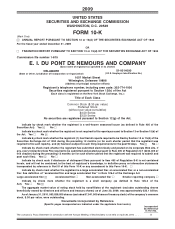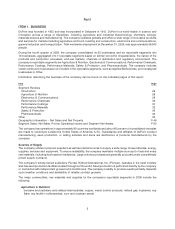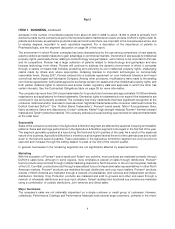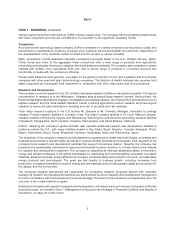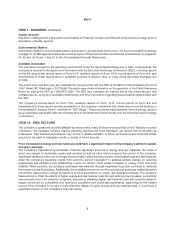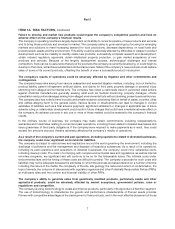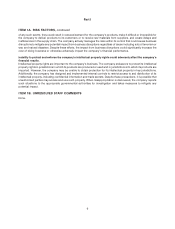DuPont 2009 Annual Report Download - page 9
Download and view the complete annual report
Please find page 9 of the 2009 DuPont annual report below. You can navigate through the pages in the report by either clicking on the pages listed below, or by using the keyword search tool below to find specific information within the annual report.Part I
ITEM 1A. RISK FACTORS, continued
products on customer acres. Demand for these products could be affected by market acceptance of genetically
modified products as well as governmental policies, laws and regulations that affect the development, manufacture
and distribution of products, including the testing and planting of seeds containing biotechnology traits and the import
of commodity grain grown from those seeds.
The company competes with major global companies that have strong intellectual property estates supporting the use
of biotechnology to enhance products, particularly in the agricultural products and production markets. Speed in
discovering and protecting new technologies and bringing products based on them to market is a significant
competitive advantage. Failure to predict and respond effectively to this competition could cause the company’s
existing or candidate products to become less competitive, adversely affecting sales.
Changes in government policies and laws could adversely affect the company’s financial results.
Sales outside the U.S. constitute approximately 60 percent of the company’s 2009 revenue. The company anticipates
that international sales will continue to represent a substantial portion of its total sales and that continued growth and
profitability will require further international expansion, particularly in emerging markets. Sales from emerging markets
represent approximately 30 percent of the company’s revenue in 2009 and the company’s growth plans include
focusing on expanding its presence in emerging markets. The company’s financial results could be affected by
changes in trade, monetary and fiscal policies, laws and regulations, or other activities of U.S. and non-U.S.
governments, agencies and similar organizations. These conditions include, but are not limited to, changes in a
country’s or region’s economic or political conditions, trade regulations affecting production, pricing and marketing of
products, local labor conditions and regulations, reduced protection of intellectual property rights in some countries,
changes in the regulatory or legal environment, restrictions on currency exchange activities, burdensome taxes and
tariffs and other trade barriers. International risks and uncertainties, including changing social and economic
conditions as well as terrorism, political hostilities and war, could lead to reduced sales and profitability.
Economic factors, including inflation, deflation and fluctuations in currency exchange rates, interest rates and
commodity prices could affect the company’s financial results.
The company is exposed to fluctuations in currency exchange rates, interest rates and commodity prices. Because the
company has significant international operations, there are a large number of currency transactions that result from
international sales, purchases, investments and borrowings. The company actively manages currency exposures that
are associated with monetary asset positions, committed currency purchases and sales and other assets and liabilities
created in the normal course of business. Failure to successfully manage these risks could have an adverse impact on
the company’s financial position, results of operations and cash flows.
Conditions in the global economy and global capital markets may adversely affect the company’s results of
operations, financial condition, and cash flows.
The company’s business and operating results may in the future be adversely affected by global economic conditions,
including instability in credit markets, declining consumer and business confidence, fluctuating commodity prices,
volatile exchange rates, and other challenges that could affect the global economy. The company’s customers may
experience deterioration of their businesses, cash flow shortages, and difficulty obtaining financing. As a result,
existing or potential customers may delay or cancel plans to purchase products and may not be able to fulfill their
obligations in a timely fashion. Further, suppliers could experience similar conditions, which could impact their ability to
fulfill their obligations to the company. Adversity within capital markets may impact future return on pension assets, thus
resulting in greater future pension costs that impact the company’s results. Future weakness in the global economy
could adversely affect the company’s results of operations, financial condition and cash flows in future periods.
Business disruptions could seriously impact the company’s future revenue and financial condition and increase
costs and expenses.
Business disruptions, including supply disruptions, increasing costs for energy, temporary plant and/or power outages
and information technology system and network disruptions, could seriously harm the company’s operations as well
as the operations of its customers and suppliers. Although it is impossible to predict the occurrences or consequences
8

